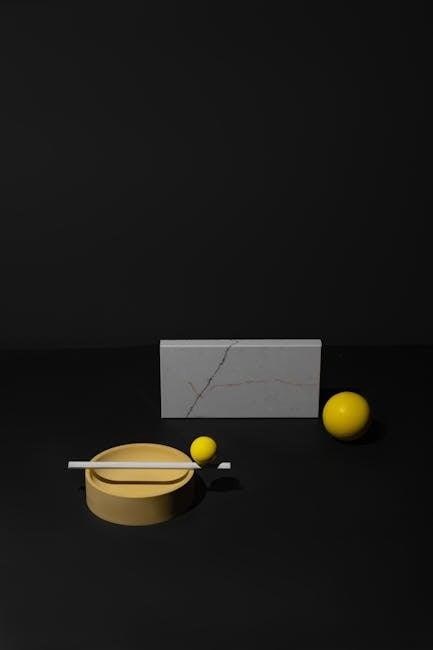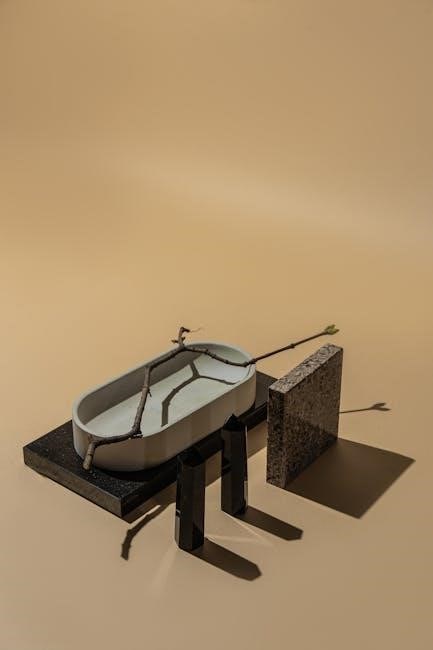Composite figures are 3D shapes formed by combining simpler geometric solids. Understanding their volume is crucial for various applications. This guide offers resources and strategies to help students master volume calculations using worksheets and real-world scenarios.
Definition of Composite Figures
Composite figures are complex three-dimensional shapes formed by combining two or more basic geometric solids‚ such as prisms‚ pyramids‚ cylinders‚ cones‚ and spheres. These figures can be created by adding or subtracting simpler shapes‚ resulting in unique structures. For instance‚ a composite figure might consist of a rectangular prism attached to a triangular prism or a cylinder with a hemisphere on top. Understanding composite figures is essential for calculating volumes in real-world applications‚ such as architecture‚ engineering‚ and product design. Worksheets on composite figures often involve identifying individual shapes‚ calculating their volumes‚ and then combining or subtracting them to find the total volume of the composite structure.
Importance of Understanding Composite Figures
Understanding composite figures is crucial for developing problem-solving skills in geometry and real-world applications. Composite figures‚ made by combining simpler shapes‚ help students grasp spatial relationships and volume calculations. This skill is vital in fields like architecture‚ engineering‚ and product design‚ where complex structures are often broken down into basic components. Mastering composite figures enhances mathematical reasoning and prepares students for advanced concepts in geometry and calculus. Worksheets on composite figures provide practical exercises to apply volume formulas‚ ensuring a strong foundation for future academic and professional challenges. They also foster critical thinking and precision in mathematical computations.
Common Applications of Composite Figures in Real Life
Composite figures are widely used in architecture‚ engineering‚ and product design to create complex structures. Architects often combine simple shapes to design buildings or bridges‚ while engineers use them to model machines or mechanisms. In product design‚ composite figures help create ergonomic and functional items like furniture or appliances. Artists and sculptors also utilize composite shapes to craft intricate designs. These real-world applications highlight the importance of understanding how to break down complex structures into simpler components‚ calculate their volumes‚ and solve practical problems. Worksheets on composite figures provide hands-on practice‚ enabling students to apply mathematical concepts to real-world scenarios effectively.

Basic Concepts of Volume Calculation
Volume is the space occupied by a 3D object. Composite figures are formed by combining simpler shapes like prisms‚ cylinders‚ and cones. Calculating their volume involves adding or subtracting the volumes of these individual components using their respective formulas.
Understanding Volume and Its Measurement
Volume measures the space occupied by a three-dimensional object. It is expressed in cubic units‚ such as cubic centimeters (cm³) or cubic inches (in³). For composite figures‚ volume is determined by breaking them into simpler shapes like prisms‚ cylinders‚ or cones. Each component’s volume is calculated using specific formulas‚ such as V = lwh for rectangular prisms or V = πr²h for cylinders. The total volume is then found by adding or subtracting these individual volumes. Accurate measurement requires precise dimensions and applying the correct geometric formulas. This skill is essential for real-world applications‚ including architecture‚ engineering‚ and product design‚ where understanding volume helps in problem-solving and creating efficient designs.
Key Geometric Shapes in Composite Figures
Composite figures are often composed of basic 3D shapes‚ including rectangular prisms‚ cylinders‚ cones‚ pyramids‚ spheres‚ and hemispheres. These shapes are fundamental because their volumes can be easily calculated using standard formulas. For example‚ rectangular prisms use V = lwh‚ while cylinders use V = πr²h‚ and cones use V = (1/3)πr²h. Spheres and hemispheres also play a role‚ with volumes calculated using V = (4/3)πr³ and V = (2/3)πr³‚ respectively. Identifying these shapes within a composite figure is the first step in determining its total volume. Understanding these basic components is essential for mastering volume calculations in more complex scenarios.
Volume Formulas for Basic 3D Shapes
Mastering volume formulas for basic 3D shapes is essential for calculating the volume of composite figures. A rectangular prism’s volume is found using V = lwh‚ where l‚ w‚ and h are length‚ width‚ and height. For a cylinder‚ the formula is V = πr²h‚ with r as the radius and h as the height. A cone’s volume is calculated using V = (1/3)πr²h. Spheres use V = (4/3)πr³‚ while hemispheres require V = (2/3)πr³. Pyramids‚ including square pyramids‚ use V = (1/3)Bh‚ where B is the base area and h is the height. These formulas are foundational for breaking down and calculating the volume of complex composite figures.

Step-by-Step Approach to Finding Volume
Identify individual shapes‚ calculate each volume using specific formulas‚ and combine the results to find the total volume of the composite figure accurately.
Identifying Individual Shapes Within a Composite Figure
Identifying individual shapes within a composite figure is the first step in calculating its total volume. Composite figures are often made up of common 3D shapes like prisms‚ cylinders‚ cones‚ and pyramids. To begin‚ visually analyze the figure to recognize its components. For example‚ a composite shape might consist of a rectangular prism attached to a triangular prism or a cylinder combined with a hemisphere. Once the individual shapes are identified‚ their volumes can be calculated separately using specific formulas. This step ensures accuracy and simplifies the overall process. Practice with worksheets helps students develop this skill‚ making it easier to break down complex figures into manageable parts for volume calculation.

Calculating the Volume of Each Component
After identifying the individual shapes within a composite figure‚ the next step is to calculate the volume of each component. This requires applying specific volume formulas for each identified shape‚ such as rectangular prisms (length × width × height)‚ cylinders (π × radius² × height)‚ and cones (1/3 × π × radius² × height). Ensure precise measurements are used for accurate calculations. For example‚ if a composite figure consists of a rectangular prism and a cylinder‚ calculate each volume separately before combining them. Practice worksheets often provide dimensions and guide students through this process‚ reinforcing the application of formulas and attention to detail. This step is essential for obtaining the correct total volume of the composite figure.
Combining Volumes to Find the Total Volume
After calculating the volume of each individual component‚ the next step is to combine these volumes to find the total volume of the composite figure. This involves summing the volumes of all identified shapes. For example‚ if a composite figure consists of a rectangular prism and a cylinder‚ add their individual volumes to obtain the total volume. Ensure that all measurements are in the same unit system (e.g.‚ centimeters or inches) to avoid errors. Worksheets often include exercises where students practice adding and subtracting volumes‚ reinforcing the concept of combining simple shapes to form complex ones. This step is crucial for accurately determining the total volume and applying it to real-world problems in architecture‚ engineering‚ and design.

Adding and Subtracting Volumes
Adding and subtracting volumes is essential for determining the total volume of composite figures. Worksheets often involve calculating the volume of individual components and then combining or subtracting them to find the final volume‚ ensuring accuracy in complex geometric problems.
When to Add Volumes in Composite Figures
Add volumes when a composite figure is formed by combining two or more distinct 3D shapes without overlapping. Calculate each shape’s volume separately and sum them for the total volume. This method is essential for understanding how individual components contribute to the whole‚ especially in architectural and engineering applications. Worksheets often provide exercises where students identify and add volumes of prisms‚ cylinders‚ and cones to find the total volume of complex figures. This approach helps reinforce the concept of breaking down complex structures into simpler‚ manageable parts for accurate volume calculation.
When to Subtract Volumes in Composite Figures
Subtract volumes when a composite figure includes voids or hollow sections within a larger shape. To find the volume of the shaded or solid region‚ calculate the total volume of the larger figure and subtract the volume of the unshaded or hollow part. This method is useful in scenarios where a portion of the figure is empty or removed. Worksheets often include problems where students must identify and subtract the volume of unshaded regions to find the remaining volume. This approach is particularly relevant in engineering and product design‚ where understanding the volume of materials is critical. Accurate subtraction ensures precise calculations for real-world applications.

Practical Examples of Adding and Subtracting Volumes
Practical examples of adding and subtracting volumes involve real-world scenarios where composite figures are common. For instance‚ calculating the volume of a building with multiple prisms or a machine part with hollow sections. Worksheets often include problems like finding the volume of a composite shape made by joining a cylinder and a cone or subtracting the volume of a sphere from a larger rectangular prism. These exercises help students understand how to break down complex figures into simpler shapes‚ apply volume formulas‚ and perform accurate calculations. Such skills are essential for fields like architecture‚ engineering‚ and product design‚ where precise volume measurements are critical for material planning and construction.

Worksheets for Practice
Free printable volume of composite figures worksheet pdf resources are available online‚ offering comprehensive exercises for practicing volume calculations. These PDF worksheets include various composite shapes‚ such as prisms‚ cylinders‚ and cones‚ allowing students to practice breaking down complex figures into simpler components. They cover both adding and subtracting volumes‚ providing a hands-on approach to mastering the concept. Suitable for different grade levels‚ these worksheets are ideal for reinforcing learning and improving problem-solving skills in geometry and volume calculations.
Types of Worksheets Available for Composite Figures
Various types of volume of composite figures worksheet pdf resources are available to cater to different learning needs. Basic worksheets focus on additive volume problems‚ where students sum the volumes of individual shapes. Advanced sheets include subtractive volume tasks‚ requiring the subtraction of unshaded regions. Some worksheets feature real-world scenarios‚ blending practical applications with geometric calculations. Others provide step-by-step examples to guide learners through complex problems. Worksheets are available for different grade levels‚ from middle school to high school‚ ensuring relevance and challenge. Many resources offer interactive tools or answer keys for self-assessment. Whether printed or digital‚ these worksheets are designed to enhance understanding and proficiency in calculating composite figure volumes.
How to Choose the Right Worksheet for Your Needs
Selecting the appropriate worksheet for calculating the volume of composite figures involves considering several factors. First‚ assess your skill level: choose basic worksheets with step-by-step guidance if you’re a beginner‚ or opt for advanced sheets with complex figures and real-world applications if you’re more experienced. Next‚ evaluate the types of problems: decide whether you need additive‚ subtractive‚ or mixed volume tasks. Consider the format: traditional numeric problems‚ word problems‚ or interactive exercises. Ensure the worksheet uses the correct measurement units (U.S. customary or metric) aligned with your needs. Check the answer key detail: detailed solutions for learning or concise answers for self-assessment. Finally‚ choose between printable PDFs for hands-on practice or interactive tools for digital engagement. Prioritize reputable sources like educational websites or school resources for accuracy and relevance.
Using Worksheets to Reinforce Learning
Worksheets are an effective way to reinforce learning and master the concept of calculating the volume of composite figures. By breaking down complex shapes into simpler components‚ students can practice applying volume formulas and improve their problem-solving skills. Regular practice with worksheets helps build confidence and fluency in handling both additive and subtractive volume tasks. Additionally‚ worksheets with answer keys provide immediate feedback‚ allowing students to identify and correct mistakes; Over time‚ consistent use of these resources enhances spatial reasoning and mathematical accuracy‚ making them an invaluable tool for students at all skill levels. They also cater to different learning preferences‚ offering options for both printable PDFs and interactive digital exercises.
Real-World Applications of Composite Figures
Composite figures are essential in architecture‚ engineering‚ and product design‚ where complex shapes are broken into simpler components for precise volume calculations‚ ensuring practical and functional designs.
Architecture and Engineering
In architecture and engineering‚ composite figures are frequently used to design complex structures. By breaking these structures into simpler geometric shapes‚ professionals can calculate volumes with precision. This is crucial for ensuring stability‚ functionality‚ and material efficiency. For example‚ buildings‚ bridges‚ and infrastructure often involve composite solids‚ where understanding volume helps in estimating material requirements and structural integrity. Engineers use volume calculations to optimize designs‚ reducing costs and environmental impact. These skills are honed through practice with worksheets‚ enabling professionals to tackle real-world challenges effectively. The ability to decompose complex shapes into manageable components is a cornerstone of modern engineering and architectural practices;
Product Design and Manufacturing
In product design and manufacturing‚ understanding the volume of composite figures is essential for creating efficient and functional products. Designers often combine multiple geometric shapes to achieve desired forms‚ such as in consumer goods or machinery. Accurate volume calculations ensure proper material usage‚ minimizing waste and reducing production costs. Worksheets and practice exercises help designers master these skills‚ enabling them to optimize product designs for performance and aesthetics. Additionally‚ in manufacturing‚ volume calculations are critical for quality control and ensuring products meet specifications. The ability to work with composite figures empowers designers to innovate while maintaining practicality‚ driving advancements in both industrial and consumer markets.
Art and Sculpture
In the realm of art and sculpture‚ understanding the volume of composite figures inspires creativity and precision. Artists often combine simple geometric shapes to create complex‚ visually striking pieces. Calculating volumes helps in scaling designs and ensuring structural integrity‚ especially for large-scale installations. Worksheets and exercises provide artists with the tools to experiment with form and space‚ translating abstract ideas into tangible works. By mastering volume calculations‚ artists can achieve balance and harmony in their compositions‚ pushing the boundaries of modern and contemporary art. This blend of mathematics and creativity fosters innovation‚ making volume comprehension a valuable skill for both aesthetic and functional purposes.

Common Challenges and Solutions
Students often struggle with identifying component shapes and calculating accurate volumes. Practice with worksheets and breaking problems into steps helps overcome these challenges effectively.

Difficulty in Identifying Component Shapes
One common challenge students face is identifying individual shapes within a composite figure. Complex structures can make it hard to distinguish between prisms‚ pyramids‚ or cylinders. Breaking down the figure into simpler parts using visual decomposition or labeling dimensions helps. Encourage students to sketch and highlight each component separately. Providing diagrams with clear measurements and practicing with worksheets that focus on shape identification can improve skills. Regular practice with diverse composite figures enhances recognition and reduces confusion. Interactive tools and step-by-step guides also aid in mastering this foundational skill‚ ensuring accurate volume calculations.
Errors in Volume Calculations
Errors in volume calculations often arise from incorrect formula application or misinterpretation of shapes. Students may use the wrong formula for a component or miscalculate dimensions. Another common mistake is adding volumes when subtraction is required‚ or vice versa. Ensuring accurate measurements and double-checking calculations can minimize errors. Teachers should emphasize understanding when to add or subtract volumes based on the composite figure’s structure. Providing step-by-step examples and practice worksheets helps students identify and correct mistakes. Regular review of formulas and operations ensures proficiency. Addressing these errors early builds confidence and improves accuracy in solving complex composite figure problems.
Strategies to Overcome Common Challenges
Mastering composite figures’ volume calculations requires effective strategies to tackle challenges. Start by breaking down complex shapes into simpler‚ recognizable components like prisms‚ cylinders‚ or cones. Use visual aids or sketches to identify and label each part clearly. Practice with worksheets that focus on adding or subtracting volumes‚ ensuring accurate formula application. Regularly review volume formulas for basic shapes to avoid mix-ups. Encourage step-by-step problem-solving to minimize errors. Utilize interactive tools or online resources for hands-on practice. Collaborative learning‚ such as group work or peer discussions‚ can also clarify misconceptions. Consistent practice and feedback help build confidence and precision in handling composite figures;

Tools and Resources
Utilize online platforms like TutoringHour and Math Worksheets 4 Kids for downloadable PDFs. Explore Teachers Pay Teachers for premium resources. Interactive tools and textbooks also aid in mastering composite figure volumes.
Online Resources for Composite Figure Worksheets
Several online platforms offer comprehensive resources for practicing volume calculations of composite figures. Websites like TutoringHour and Math Worksheets 4 Kids provide free printable PDF worksheets designed for various grade levels. These resources include exercises featuring composite shapes made up of prisms‚ cylinders‚ cones‚ and more. Additionally‚ Teachers Pay Teachers offers premium worksheets with real-world scenarios‚ ideal for advanced learners. Interactive tools like LiveWorksheets convert traditional exercises into digital‚ self-correcting activities. These online resources cater to both students and educators‚ ensuring a robust learning experience.
Offline Resources and Textbooks
Offline resources and textbooks are invaluable for mastering volume calculations of composite figures. Textbooks like Big Ideas Math and Advanced Geometry Resources provide detailed chapters dedicated to composite shapes. Supplementary materials‚ such as Reflection Of Shapes Worksheet and Critical Reflection Template‚ are often included in physical workbooks. Many educational institutions‚ like the Rush-Henrietta Central School District‚ offer printed worksheet editions covering prisms‚ pyramids‚ and cones. These resources typically include answer keys‚ practice exercises‚ and real-world applications. For offline access‚ consider consulting textbooks from publishers like Larson Texts‚ Inc.. These materials are ideal for students without internet access or those preferring traditional learning methods. Always check school libraries or bookstores for these resources.
Interactive Tools for Volume Calculation
Interactive tools like LiveWorksheets transform traditional worksheets into self-correcting exercises‚ allowing students to practice online and submit work to teachers. Platforms such as Teachers Pay Teachers offer digital resources‚ including interactive worksheets for composite figures. Tools like StudyBlaze.io enable the creation of quizzes and flashcards for volume calculations. These tools often feature real-time feedback‚ helping students identify mistakes instantly. Many platforms allow students to visualize composite shapes and break them into simpler components. Interactive tools are accessible on various devices‚ making learning flexible and engaging. They are ideal for both classroom use and homework; By leveraging technology‚ these tools enhance understanding and retention of volume calculation concepts; They are particularly useful for visual learners and those needing additional practice.
Mastering composite figure volumes requires practice with worksheets and interactive tools. Regular practice helps overcome challenges and ensures proficiency in calculating complex shapes’ volumes effectively.
Composite figures are complex 3D shapes formed by combining simpler geometric solids like prisms‚ cylinders‚ and cones. To find their volume‚ students must break them into individual components‚ calculate each using specific formulas‚ and then add or subtract the results. This method ensures accuracy and simplifies problem-solving. Worksheets are essential for practicing these calculations‚ as they provide structured exercises and real-world scenarios to apply the concepts. Regular practice helps students overcome challenges and builds confidence in handling complex shapes. Understanding composite figures is vital for advanced math and real-world applications in architecture‚ engineering‚ and design.
Encouragement to Practice Regularly
Regular practice is essential for mastering the calculation of composite figure volumes. Consistent effort helps students develop problem-solving skills and confidence. Utilize worksheets and interactive tools to engage with exercises tailored to different skill levels. Breaking down complex shapes into simpler components reinforces understanding. Over time‚ practice reduces errors and builds intuition. Encourage learners to explore real-world applications‚ making the concept more relatable and interesting. Dedication and persistence lead to proficiency in handling composite figures‚ preparing students for advanced math and practical scenarios.
Final Thoughts on Mastering Composite Figures
Mastery of composite figures’ volume calculation is a valuable skill with wide-ranging applications in fields like architecture‚ engineering‚ and design. By consistently practicing with worksheets and interactive tools‚ students can build confidence and accuracy. The ability to break down complex shapes into simpler components enhances problem-solving abilities and spatial reasoning. Embrace challenges‚ learn from errors‚ and celebrate progress. With dedication‚ anyone can achieve proficiency in calculating volumes of composite figures‚ unlocking a deeper understanding of geometry and its real-world applications. Keep exploring‚ practicing‚ and pushing your limits to become a master of composite figures!
